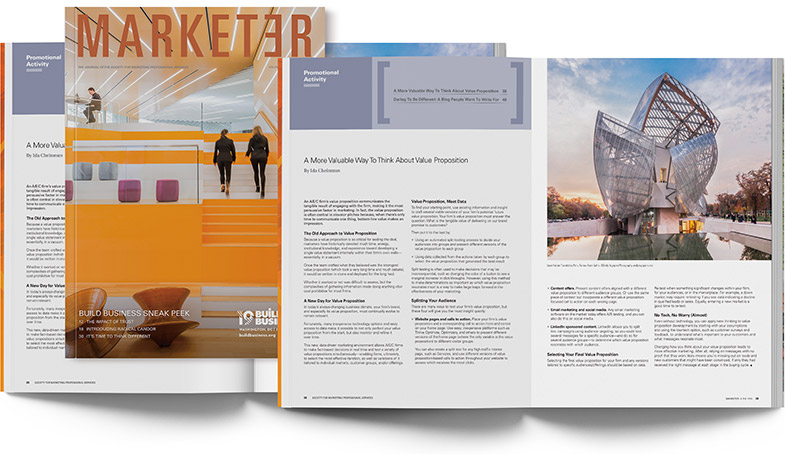The article was first published in ©Marketer, The Journal of the Society for Marketing Professional Services

An A/E/C firm’s value proposition communicates the tangible result of engaging with the firm, making it the single most persuasive factor in marketing. In fact, the value proposition is often central in elevator pitches because, when there’s only time to communicate one thing, bottom-line value makes an impression.
The Old Approach to Value Proposition
Because a value proposition is so critical for sealing the deal, marketers have historically devoted much time, energy, institutional knowledge, and past experience toward developing a single value statement internally within their firm’s own walls – essentially, in a vacuum.
Once the team crafted what they believed was the strongest value proposition (which took a very long time and much debate), it would be written in stone and deployed for the long haul.
Whether it actually worked or not was difficult to assess, but the complexities of gathering information made doing anything else cost prohibitive for most firms.
A New Day for Value Proposition
In today’s always-changing business climate, your firm’s brand, and especially its value proposition, must continually evolve to remain relevant.
Fortunately, many inexpensive technology options and easy access to data make it possible to not only perfect your value proposition from the start, but also monitor and perfect it over time.
This new, data-driven marketing environment allows A/E/C firms to make fact-based decisions in real time and test a variety of value propositions simultaneously – enabling firms, ultimately, to select the most effective iteration, as well as variations of it tailored to individual markets, customer groups, and/or offerings.
Value Proposition, Meet Data
To find your starting point, use existing information and insight to craft several viable versions of your firm’s potential future value proposition. Your firm’s value proposition must answer the question: What is the tangible value of delivering on our brand promise to customers?
Then put them to the test by:
- Using an automated split testing process to divide your audiences into groups and present different versions of the value proposition to each
- Using data collected from to the actions taken by each group to select the value proposition that generated the best result
Split testing is often misused to make decisions that are inconsequential, such as changing the color of a button to see a marginal increase in click-throughs. However, using this method to make determinations as important as which value proposition resonates most is a way to make large leaps forward in the effectiveness of your marketing.
Splitting Your Audience
There are many ways to test your firm’s value proposition, but these three will give you the most insight quickly:
- Website Pages and Calls to Action: Place your firm’s value proposition and a corresponding call to action front and center on your home page. Use easy, inexpensive platforms such as Thrive Optimize, Optimizely, and others to present different versions of the home page (where the only variable is the value proposition) to different visitor groups. You can also create a split test for any high-traffic interior page, such as Services, and use different versions of value proposition-based calls to action throughout your website to assess which receives the most clicks.
- Content Offers: Present content offers aligned with a different value proposition to different audience groups. Or use the same piece of content but incorporate a different value proposition-focused call to action on each landing page.
- Email Marketing and Social Media: Any email marketing software on the market today offers A/B testing, and you can also do this on social media.
- LinkedIn Sponsored Content: LinkedIn allows you to split test campaigns using audience targeting, so you could test several messages for a specific audience—and do so for several audience groups – to determine which value proposition resonates with which audience.
Selecting Your Final Value Proposition
Selecting the final value proposition for your firm and any versions tailored to specific audiences/offerings should be based on data.
Re-test when something significant changes within your firm, for your audiences, or in the marketplace. For example, a down market may require re-testing if you see data indicating a decline in qualified leads or sales. Equally, entering a new market is a good time to re-test.
No Tech, No Worry (Almost)
Even without technology you can apply new thinking to value proposition development by starting with your assumptions and using the low-tech option, such as customer surveys and feedback, to understand what’s important to your customers and what messages resonate most.
Changing the way you think about your value proposition leads to more effective marketing. After all, relying on messages with no real proof they work likely means you’re missing out on leads and new customers that might have been convinced, if only they had received the right message at each stage in the buying cycle.
Related Resources
Do You Understand the Anatomy of Your Brand?
Brand Purpose Is the New Brand Promise
New Rules of Branding – How to Build an Unbeatable Edge
Actionable ideas delivered straight to your inbox
Subscribe